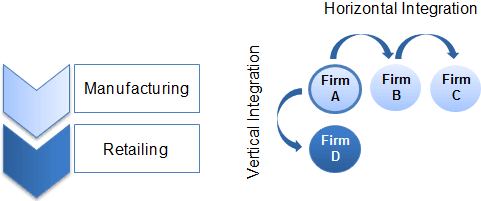Definition
Horizontal integration is the process of acquiring or merging with competitors, leading to industry consolidation.
Horizontal integration is a strategy where a company acquires, mergers or takes over another company in the same industry value chain.
What is horizontal integration?
It is a type of integration strategies pursued by a company in order to strengthen its position in the industry. A corporate that implements this type of strategy usually mergers or acquires another company that is in the same production stage. For example, Disney merging with Pixar (movie production), Exxon with Mobile (oil production, refining and distribution) or the infamous Daimler Benz and Chrysler merger (car developing, manufacturing and retailing).
The purpose of horizontal integration (HI) is to grow the company in size, increase product differentiation, achieve economies of scale, reduce competition or access new markets. When many firms pursue this strategy in the same industry, it leads to industry consolidation (oligopoly or even monopoly).
HI can occur in a form of mergers, acquisitions or hostile takeovers. Merger is the joining of two similar sizes, independent companies to make one joint entity. Acquisition is the purchase of another company. Hostile takeover is the acquisition of the company, which does not want to be acquired.
HI may be an effective strategy when:
- Organization competes in a growing industry.
- Competitors lack of some capabilities, competencies, skills or resources that the company already possesses.
- HI would lead to a monopoly that is allowed by a government.
- Economies of scale would have significant effect.
- The organization has sufficient resources to manage M&A.
The following diagram illustrates HI in manufacturing industry:

Difference between horizontal and vertical integrations
HI is different from vertical integration, where a firm usually expands into another production stage rather than merging or acquiring the company in the same production stage. For example, a company is vertically integrating if it expands from manufacturing industry to retailing industry, while HI would mean buying other firms in the same manufacturing industry.

Horizontal integration examples
| Acquiring company | Acquired company |
|---|---|
| Amazon.com | Whole Foods |
| Porsche | Volkswagen |
| Daimler Benz | Chrysler |
| Kraft Foods | Cadbury |
| Quaker Oats | Snapple |
| PepsiCo | Quaker Oats |
| Pfizer | Wyeth |
| Pfizer | Pharmacia Corporation |
| Glaxo Wellcome | SmithKline Beecham |
| AT&T | T-Mobile |
| AT&T | Bell South |
| Mittal Steel | Arcelor |
| HP | Compaq |
| Oracle | PeopleSoft |
| Delta | Northwest Airlines |
| United Airlines | Continental |
| JPMorgan Chase | Bank One |
| Microsoft | Taleo |
| Microsoft | Yahoo! |
| Apple | AuthenTec |
| BP | Amoco |
Source: Strategic Management Insight
Advantages of horizontal integration
- Lower costs. The result of HI is one larger company, which produces more services and products. The higher output leads to greater economies of scale and higher efficiency.
- Increased differentiation. The combined company can offer more product or service features.
- Increased market power. The larger company has more power over its suppliers and distributors/customers.
- Reduced competition. The result of industry consolidation is fewer companies operating in the industry and less intense competition.
- Access to new markets. New markets and distribution channels can be accessed by integrating with a company that produces the same goods but operates in a different region or serves different market segment.
Disadvantages of the strategy
- Destroyed value. M&A rarely add value to the companies. More often M&A fail and destroy the value of the companies involved in it because expected synergies never materialize.
- Legal repercussions. HI can lead to a monopoly, which is highly discouraged by many governments due to lack of competition. Therefore, governments usually have to approve any larger M&A before they can happen.
- Reduced flexibility. Large organizations are harder to manage and they are less flexible in introducing innovations to the market.
Sources
- Vassoughi, S. at Harvard Business Review (2012). Today’s Best Companies are Horizontally Integrated. Available at: https://hbr.org/2012/12/todays-best-companies-are-hori

